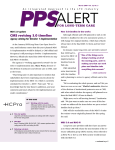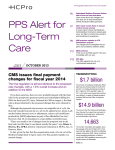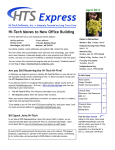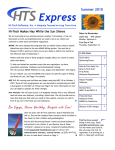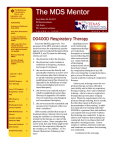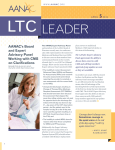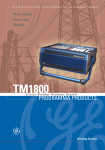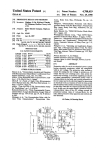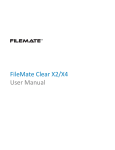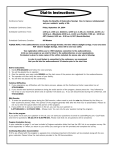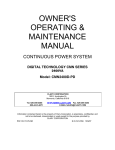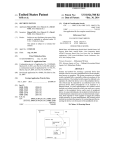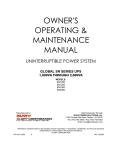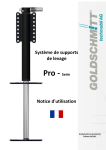Download CMS launches five-star rating system
Transcript
February 2009 Vol. 12, No. 2 CMS launches five-star rating system Providers need to communicate true quality to the public Now that consumers can easily access nursing home quality ratings, long-term care providers say the industry needs to communicate the aspects of nursing home quality that the five-star rating system doesn’t capture. In December 2008, CMS posted its five-star quality about their successes,” says Barbara Bruhm, RN, BN, HSM, executive director of consulting services at Landmark Health in Haverhill, MA. “But the buildings that didn’t score well need to tell their story too and explain to families, residents, and staff why they received the rating they did and the actions that they take every day to maintain quality care.” Educating consumers about quality At a December press conference, Kerry Weems, CMS rating system on the Nursing Home Compare Web site. acting administrator, said he wouldn’t tell consumers to The rating system uses data from surveys, staffing rates, eliminate one-star facilities from consideration but would and 10 quality measures to calculate star ratings, ranging recommend that from one to five. consumers carefully When the rating system was unveiled, many long- evaluate those facil- “The biggest miss with the five-star system is that it doesn’t measure what we term care providers said the system oversimplified ities to understand nursing home quality and didn’t account for customer why they received satisfaction. Regardless of the system’s flaws, long-term one-star ratings. care providers will still have to live with the five-star rat- Weems added that ing system. “I think the centers that got five stars should when choosing a tell all of their families, their staff, and their residents facility, no rating system or Web site can substitute for think is a very important measure, and that’s customer satisfaction.” —Richard C. Bane, MBA, FACHCA visiting a nursing home and talking with nursing facility IN THIS ISSUE p. 4 Beneficiary notifications We give you a complete guide to simplifying the beneficiary notification process at your facility, including a chart of notifications and a quiz. p. 8 Compliance programs The Office of Inspector General recently released supplemental compliance guidance for nursing facilities. Learn how to get started at your facility. p. 10 MDS 3.0 question of the month management, state ombudsmen, and residents’ families. However, many long-term care providers are concerned that consumers will rely too heavily on star ratings. “Unless [consumers] really understand the criteria that went into the rating system and the criteria that didn’t, they’re not going to have all the information to make the best choice for themselves and their family members,” Bruhm says. “We need to educate people.” Find out what your peers are asking about at MDSCentral. p. 11 PPS Q&A Rena R. Shephard, MHA, RN, RAC-MT, C-NE, answers questions about respiratory therapy, ICD-9 coding, and more. How the ratings work The five-star rating system’s methodology is fairly complex and can be difficult to understand, even for long-term care providers. > continued on p. 2 PPS Alert for Long-Term Care Page 2 Five-star rating February 2009 < continued from p. 1 In a nutshell, facilities receive one to five stars for –– Experienced activities-of-daily-living (ADL) decline each of the following domains: –– Experienced decline of mobility ➤➤ The health inspection domain is calculated from –– Have high-risk pressure ulcers the three most recent years of surveys, as well as –– Have catheters results from complaint investigations in the previous –– Are physically restrained three years. Deficiencies are weighted according to –– Have urinary tract infections scope and severity, and the number of repeat revisits –– Have moderate to severe pain required to correct a deficiency is considered. ➤➤ The staffing domain is based on the number of RN For short-stay residents, the rating system evaluates and overall staff hours (this combines RN, licensed what percentage of residents have: practical nurse, and nursing assistant hours) each ➤➤ Pressure ulcers resident receives per day. The score is adjusted for ➤➤ Delirium case-mix differences. ➤➤ Moderate to severe pain ➤➤ The quality measure domain is derived from longand short-stay quality measures from the MDS. For The system uses the following calculation to determine long-stay residents, the system evaluates what per- a nursing home’s overall star rating: cent of a facility’s residents: 1. Start with the facility’s health inspection rating. 2. For facilities with a four- or five-star staffing rating, Editorial Advisory Board PPS Alert for Long-Term Care Group Publisher: Emily Sheahan ities with a one-star staffing rating, subtract one star Associate Editor: Emily Beaver, [email protected] from the inspection rating. Sandra Fitzler Senior Director of Clinical Services American Health Care Association Washington, DC Ronald A. Orth, RN, NHA, RAC-CT, CPC President Clinical Reimbursement Solutions, LLC Milwaukee, WI Bonnie G. Foster, RN, BSN, MEd Long-Term Care Consultant Columbia, SC Rita Roedel, MS, RN National Director of Clinical Reimbursement Extendicare Health Services, Inc. Milwaukee, WI Cindy Frakes Owner Winter Meadow Homes, Inc. Topeka, KS Julia Hopp, MS, RN, CNAA, BC Vice President of Patient Accounting Paramount Health Care Company San Antonio, TX Steven B. Littlehale, MS, GCNS-BC Executive Vice President, Healthcare Chief Clinical Officer PointRight, Inc. Lexington, MA Rena R. Shephard, MHA, RN, RAC-MT, C-NE PPSA Senior Advisor Founding Chair and Executive Editor American Association of Nurse Assessment Coordinators President RRS Healthcare Consulting Services San Diego, CA Holly F. Sox, RN, RAC-C MDS and Staff Development Coordinator NHC Lexington West Columbia, SC PPS Alert for Long-Term Care (ISSN: 1521-4990 [print]; 1937-7428 [online]) is published monthly by HCPro, Inc., 200 Hoods Lane, Marblehead, MA 01945. Subscription rate: $239/year. • PPS Alert for Long-Term Care, P.O. Box 1168, Marblehead, MA 01945. • Copyright © 2009 HCPro, Inc. • All rights reserved. Printed in the USA. Except where specifically encouraged, no part of this publication may be reproduced, in any form or by any means, without prior written consent of HCPro, Inc., or the Copyright Clearance Center at 978/750-8400. Please notify us immediately if you have received an unauthorized copy. • For editorial comments or questions, call 781/639-1872 or fax 781/639-2982. For renewal or subscription information, call customer service at 800/650-6787, fax 800/639-8511, or e-mail: [email protected]. • Visit our Web site at www. hcpro.com. • Occasionally, we make our subscriber list available to selected companies/vendors. If you do not wish to be included on this mailing list, please write to the marketing department at the address above. • Opinions expressed are not necessarily those of PPSA. Mention of products and services does not constitute endorsement. Advice given is general, and readers should consult professional counsel for specific legal, ethical, or clinical questions. © 2009 HCPro, Inc. add one star to the health inspection rating. For facil- 3. For facilities with a five-star rating for quality measures, add one star. For facilities with a one-star quality measure rating, subtract one star. A facility cannot receive more than five stars or fewer than one star. Additional rules apply to the rating calculation for Special Focus Facilities that have not graduated and facilities that received a one-star health inspection rating. For a detailed explanation of the calculation, find CMS’ technical users’ manual by visiting www.cms.hhs.gov/CertificationandComplianc and clicking on the “Five-Star Quality Rating System” manual on the left side of the page. Scroll down to the Downloads section. Using survey to score facilities Long-term care industry groups object that the rating system is based on what they call a broken survey system. For permission to reproduce part or all of this newsletter for external distribution or use in educational packets, contact the Copyright Clearance Center at www.copyright.com or 978/750-8400. PPS Alert for Long-Term Care February 2009 Members of the long-term care industry are concerned that a survey deficiency could skew a facility’s rating, says Sherrie Dornberger, RNC, CDONA, Page 3 BaneCare, LLC, which operates several nursing facilities in Massachusetts. In Massachusetts, long-term care providers worked with FACDONA, president of the National Association of the state legislature and department of public health to Directors of Nursing Administration. conduct customer satisfaction surveys in 2005 and 2007. Dornberger offers an example from a facility she In both surveys, nine out of 10 respondents statewide said worked in. The facility served raisin toast at breakfast, they would recommend their nursing home to a friend or which was extremely popular with residents. H owever, family members. “To have that kind of performance and during a survey, a surveyor turned a toaster upside to have that not be recognized in a five-star rating is crazy, down and a raisin fell out. The facility received an infec- particularly because the five-star rating is intended to focus tion control deficiency. on the needs of the consumer,” Bane says. Most nursing facility staff members understand that At the December press conference, Weems said CMS a seemingly minor infraction can lead to a survey defi- would like to include customer satisfaction in the rating ciency that remains on a facility’s record for a long time. system in the future. However, consumers may not be aware of this when viewing a nursing home star rating. Communicating with customers and CMS Word of mouth is still the No. 1 factor for families and Using ratings to improve Although imperfect, the five-star rating system offers nursing facilities opportunities to compare themselves to other facilities and improve in certain areas. Dornberger says she was pleased to see that the sys- residents choosing a nursing home, but more people are using the Internet to get information about facilities, Bane says. Providers should encourage people to make sure the Internet is not the only source of information used when tem highlights the importance of providing RN hours for selecting a nursing facility. “Matching the needs of the resident care and gives facilities a federal benchmark for resident with the skill set of the particular nursing home staffing hours. is the most important thing,” Bane says. “There’s not a Facilities should look at their rating from a performance consumer Web site nor any information you can get on improvement point of view, Bruhm says. Members of the the Web that can tell you whether nursing home X, Y, interdisciplinary team should meet and analyze their facil- or Z is the right place for your mother.” ity’s ratings: Does the facility have ADL decline? Why does Nursing facilities should tell consumers about measures it have a high percentage of catheters? Are we managing of quality not included in the five-star system, such as spe- residents’ continence? Are we aware of regulations and cial programs or high customer satisfaction, says Bruhm. complying with them? Providers are hoping to work with CMS as a partner to give feedback on how to improve the rating system, Counting customer satisfaction says Bane. n Many members of the long-term care industry are disappointed the five-star rating system doesn’t account for customer satisfaction. “The biggest miss with the five-star system is that it doesn’t measure what we think is a very important measure, and that’s customer satisfaction,” explains Relocating? Taking a new job? If you’re relocating or taking a new job and would like to continue receiving PPSA, you are eligible for a free trial subscription. Contact customer service with your moving information at 800/650-6787. Richard C. Bane, MBA, FACHCA, president of © 2009 HCPro, Inc. For permission to reproduce part or all of this newsletter for external distribution or use in educational packets, contact the Copyright Clearance Center at www.copyright.com or 978/750-8400. PPS Alert for Long-Term Care Page 4 February 2009 Beneficiary notifications: Simplify the process at your SNF notifications are mandatory and which are optional, says After reading this article, you will be able to: ➤➤ State which beneficiary notifications are mandatory ➤➤ Identify the rights processes associated with advanced beneficiary notifications (ABN) and expedited determination notices (EDN) ➤➤ Name the notices that must be issued under Medicare Part A and Part B ➤➤ Explain when the Notice of Exclusion from Medicare Benefits (NEMB) form may be used ➤➤ Name the notifications issued under the Expedited Review Process Claudia Reingruber, CPA, managing shareholder of Reingruber & Company, PA, in St. Petersburg, FL. All of the notifications can be found at CMS’ Beneficiary Notices Initiative Web page at www.cms.hhs.gov/BNI. SNFs must provide the following kinds of beneficiary notices: ➤➤ SNF ABN or SNF d enial letters for Part A services ➤➤ ABN for Part B services ➤➤ EDNs for Part A and Part B ABNs and EDNs represent two different appeal rights and processes. The EDN gives the beneficiary the right to an expedited review through a QIO, and the ABNs or Beneficiary notifications give Medicare beneficiaries important information about their benefits and protect SNFs from financial liability, but the regulations for the SNF denial letters give the right to appeal to the fiscal intermediary (FI) using the demand bill process. For example, if your facility has a resident in a Medi- notification process can be confusing. SNFs must issue care Part A stay and Part A services are ending, you several kinds of notifications and many facilities have would issue the SNF ABN or denial letters and an EDN, several staff members responsible for notifications. says Reingruber. “A lot of facilities don’t have a process for issuing no- If you have a resident who is receiving therapy under tifications and assume a certain person is doing it,” says Part B, and the resident’s family wants him or her to con- Theresa Lang, RN, BSN, RAC-C, WCC, vice president tinue therapy beyond medical necessity, provided the of clinical consulting at Specialized Medical Services, Inc., therapy caps have not been met, you would need to in Milwaukee. issue an EDN and an ABN/ABN-G, she says. Sometimes, when that staff member leaves the facil- Note: SNFs must begin using the revised ABN in place ity, beneficiary notification isn’t reassigned, and notices of the ABN-G beginning March 1, according to CMS may not be issued properly, Lang says. officials. “It’s not until you wind up with a survey problem, demand bill, or a Quality Improvement Organization [QIO] request that facilities realize that the notices aren’t being issued correctly,” she says. Avoid survey and financial liability problems by learn- Notifications and the therapy caps Providers should inform residents they are responsible for all costs of therapy beyond the therapy caps, according to Medicare Transmittal 1106. The 2009 cap is $1,840 ing which notices your facility must issue and creating a for physical and speech therapy combined, and $1,840 system for issuing beneficiary notifications properly. for occupational therapy. Transmittal 1106 states that “although use of the Beneficiary notification background One of the first steps to improving the beneficiary notification process at your facility is understanding which © 2009 HCPro, Inc. NEMB form is not a Medicare requirement, Medicare contractors shall advise providers to use the NEMB form, or a similar form of their own d esign to inform For permission to reproduce part or all of this newsletter for external distribution or use in educational packets, contact the Copyright Clearance Center at www.copyright.com or 978/750-8400. PPS Alert for Long-Term Care February 2009 Page 5 beneficiaries of the therapy financial limitation and expect Medicare coverage of services will end. This the cap exclusion process.” process involves issuing EDNs, which may need to be However, the exceptions process is in place for 2009, given in addition to ABNs. For more information about so residents for whom therapy is deemed medically nec- when ABNs and EDNs are issued, see “Guide to SNF essary may receive therapy services exceeding the caps. beneficiary notifications” on p. 7. Note: The word “should” means it’s good practice The Generic Notice, CMS 10123, must be given to the rather than mandatory. Also, deductibles and coinsur- beneficiary two days before services are discontinued. ance apply to the therapy caps, so notify beneficiaries The Detailed Notice, CMS 10124, must be provided to well before they approach the limit. the beneficiary and the QIO when a beneficiary requests an expedited determination. Revised SNF ABN Part of SNFs’ confusion about beneficiary notices Medicare Advantage residents receive different EDNs than Medicare fee-for-service residents. Medicare Advan- results from having to choose from multiple kinds of tage residents receive the Notice of Medicare Non-Cover- ABNs when issuing that form of beneficiary notification. age, which alerts them that Medicare-covered items or When Part A services are ending but the resident will services are ending and gives them the opportunity to remain in the SNF for custodial care or therapy, SNFs request an EDN from a QIO. can issue the SNF ABN (form CMS 10055) or one of five SNF denial letters. SNFs are still awaiting the arrival of a new SNF ABN The Detailed Explanation of Non-Coverage is issued when a QIO review is requested to give more explanation of why coverage is ending. form, which is expected to replace the use of multiple ABNs. At a December 11, 2008, SNF Long-Term Care Open Door Forum, CMS officials said they hoped the revised SNF ABN would be available this spring or summer. The revised SNF ABN would require providers to issue only the SNF ABN in conjunction with the appropriate EDN, according to a CMS Town Hall presentation. Beneficiary notification basics SNF staff members should also understand how to issue notices properly. Lang says she frequently sees providers using outdated beneficiary notification forms. If your facility completes beneficiary notices improperly, your notifications could be considered invalid, says Using the NEMB The NEMB is used when the technical requirements for coverage within a Part A stay, such as a three-day Karen Connor, director of business operations for Landmark Health in Haverhill, MA. Connor suggests ensuring that notices have: qualifying hospital stay, are not met, Reingruber says. ➤➤ The beneficiary’s correct name and Medicare number The NEMB is voluntary. ➤➤ The correct font size, if applicable (ABNs must be Many long-term care facilities don’t complete the NEMB at all, Lang says, adding that although you may issued in a 12-point or larger font) ➤➤ Been issued in the proper time frame (e.g., the EDN not technically be required to give the NEMB, using it is Generic Notice must be issued two days before servic- a good opportunity to inform residents and their families es are discontinued) about Medicare benefits. Facilities should also ensure that staff members are tak- The expedited review process SNFs are required to notify Medicare beneficiaries of their right to an expedited review process when they © 2009 HCPro, Inc. ing the proper steps when contacting residents’ responsible parties with notices, Connor says. Beneficiary notices > continued on p. 6 For permission to reproduce part or all of this newsletter for external distribution or use in educational packets, contact the Copyright Clearance Center at www.copyright.com or 978/750-8400. PPS Alert for Long-Term Care Page 6 SNF February 2009 < continued from p. 5 contain specific instructions about the proper procedures be issued, she says. Everyone at the meeting needs to be for contacting responsible parties by telephone and mail. on the same page about a resident’s Medicare benefits FIs and Medicare administrative contractors can request beneficiary notices for a process review. and what notices should be distributed. Assign the responsibility for beneficiary notices based on your facility’s needs. If you have 300-bed facility with Creating a process for notification two MDS nurses, MDS nurses may issue notifications be- Many facilities don’t have a process for issuing benefi- cause they are aware of residents’ need for skilled servic- ciary notifications or have several different people or po- es and benefit periods, Connor says. But that system may sitions issuing notifications. Ask who is responsible for not work in a smaller facility where the MDS nurse takes notifications, Lang says. If no one knows, your facility on multiple roles, she says. may not be issuing all of the required notices. Reingruber suggests assigning notifications to specif- Make sure more than one person at your facility can issue notifications, Lang says. If only one person can is- ic staff members. Make sure the people who are respon- sue notifications, your facility may not be able to give sible for beneficiary notifications are part of your daily out notices within the appropriate time frames when Medicare meeting and are aware of when notices should that person is not available. n Beneficiary notification quiz Test your understanding of beneficiary notifications with Non-Coverage (cut/denial letter) for a resident who will the following quiz. Check your answers on p. 12. remain in the facility. 1. Mr. Johnson’s son visits the local SNF to ask about place- a. True ment for his father. Mr. Johnson spent three days in the hospital two weeks ago and has been at home for about a b. False 3. During a care conference, it was determined that Mrs. week. His physician would like him to have physical thera- Montagne could benefit from two more weeks of therapy. py due to the amount of time he was in the hospital. The Mrs. Montagne decides she does not want to stay and will facility believes Mr. Johnson will qualify for a Medicare be going home tomorrow. Which notices are the facility Part A stay. On the day of admission, Mr. Johnson walks required to give her prior to discharge? into the facility without any difficulty or aids and shows a. Generic Notice no other signs of having a clinical need for therapy. What b. Notice of Non-Coverage should the facility do? c. Both notices a.Explain to Mr. Johnson and his son that Medicare will d. No notice is required not likely cover his stay and provide an Advanced Beneficiary Notification (ABN) for rethinking their option 4. Mr. Lopez is being cut from Medicare Tuesday, due to lack of a daily skilled service. He will remain in the facility b.Admit Mr. Johnson and bill Medicare for the stay under Medicaid. Which of the following notices must be c.Collect the first month’s payment for the SNF stay given to Mr. Lopez prior to being cut? up-front from Mr. Johnson d.Report Mr. Johnson’s son for fraud and misrepresentation of his father’s condition a. Notice of Non-Coverage (cut/denial letter) or SNF ABN b. Notice of Exclusion from Medicare Benefits 2. With implementation of the expedited review process, c. Generic Notice SNFs no longer need to issue a Medicare Notice of d. Detailed Notice © 2009 HCPro, Inc. For permission to reproduce part or all of this newsletter for external distribution or use in educational packets, contact the Copyright Clearance Center at www.copyright.com or 978/750-8400. February 2009 PPS Alert for Long-Term Care Page 7 Guide to SNF beneficiary notifications > continued on p. 8 © 2009 HCPro, Inc. For permission to reproduce part or all of this newsletter for external distribution or use in educational packets, contact the Copyright Clearance Center at www.copyright.com or 978/750-8400. Page 8 PPS Alert for Long-Term Care Guide to SNF beneficiary notifications Source February 2009 < continued from p. 7 Source: HCPro, Inc., based on CMS regulation and HCPro reporting. Taking steps toward compliance at your SNF OIG releases supplemental guidance for nursing homes If you’ve justified the reason your SNF does not have with no compliance program during an investigation, a compliance program because you’ve heard that having says Betsy Anderson, BSA, vice president of FR&R no program is better than having unused policies and Healthcare Consulting, Inc., in Deerfield, IL. procedures, you may be headed for trouble. Now is a good time for nursing facilities to revisit com- Although having compliance policies that your facil- pliance programs, since the OIG has recently released ity doesn’t apply or enforce may be riskier than having supplemental compliance program guidance. Although no compliance program at all, the Office of Inspector compliance programs are not mandatory, they can pro- General (OIG) still won’t look favorably upon a f acility tect your SNF from OIG investigations and penalties. © 2009 HCPro, Inc. For permission to reproduce part or all of this newsletter for external distribution or use in educational packets, contact the Copyright Clearance Center at www.copyright.com or 978/750-8400. PPS Alert for Long-Term Care February 2009 Fortunately, ensuring that your facility stays in com- Page 9 plans and compliance with HIPAA’s privacy and pliance doesn’t have to become an enormous project, security rules Anderson says. Start by learning the key elements of a Don’t put compliance on the shelf successful compliance program, identifying your facility’s risk areas, and incorporating compliance procedures The information released by the OIG in September and personnel into your current quality improvement supplements the initial compliance program guidance efforts. for nursing homes, which the agency provided in 2000. The message many facilities got was that having no Guidance for compliance compliance program was safer than having written pol- In September 2008, the OIG—the enforcement arm icies and procedures collecting dust. Many long-term of the Department of Health and Human Services— care providers reacted by not implementing a compli- released supplemental compliance guidance. ance program at all or by using a one-size-fits-all compliance program, says Mary Malone, Esq., a healthcare The guidance, which offers guidelines for nursing facilities that are implementing or evaluating their compli- attorney at Hancock, Daniel, Johnson & Nagle, PC, in ance programs, highlighted the following four risk areas Richmond, VA. for facilities: However, neither of those responses are beneficial to ➤➤ Quality of care, specifically naming sufficient staff nursing facilities, Malone says. levels, comprehensive resident care plans, appropri- Failing to implement a compliance program may put ate medication management, resident safety, and your facility at risk for OIG investigations. If your facil- appropriate psychotropic medication use ity comes under scrutiny, having a compliance plan may ➤➤ Submission of accurate claims help you avoid entering a corporate integrity agreement ➤➤ The federal anti-kickback statute (CIA), a mandatory compliance program imposed by the ➤➤ Other risk areas, including providing objective OIG. The terms and reporting requirements of a CIA information about Medicare Part D prescription drug > continued on p. 10 Tips for jump-starting your compliance program Compliance programs aren’t mandatory, but they can and clicking News Room under the Quick Links section. protect your nursing facility from Office of Inspector General Click on the press release dated 9-30-2008 and scroll to (OIG) investigations and other legal problems. the bottom of the document, where there is a link to the Mary Malone, Esq., a healthcare attorney at Hancock, Daniel, Johnson & Nagle, PC, in Richmond, VA, and Betsy Anderson, BSA, vice president of FR&R Healthcare Consulting, Inc., in Deerfield, IL, offered the following tips for facilities that want to implement a new compliance program or improve an existing one: ➤➤ Read the OIG’s guidance documents. You can find the OIG’s original compliance program guidance for nursing facilities, released in 2000, at http://oig.hhs.gov/ supplemental compliance. ➤➤ Identify areas that are particular risks for your facility, such as submission of accurate claims. ➤➤ Customize your compliance program for your facility’s individual needs, rather than using a generic plan. ➤➤ Integrate compliance efforts into your facility’s existing Medicare and quality assurance meetings, rather than adding meetings. ➤➤ Involve as many staff members as possible in compli- authorities/docs/cpgnf.pdf and the supplemental guidance ance efforts and gain their support for your compliance released in September 2008 by visiting www.oig.hhs.gov program. © 2009 HCPro, Inc. For permission to reproduce part or all of this newsletter for external distribution or use in educational packets, contact the Copyright Clearance Center at www.copyright.com or 978/750-8400. PPS Alert for Long-Term Care Page 10 Compliance February 2009 < continued from p. 9 are likely to be harsher than your own compliance pro- keep in mind that compliance isn’t an all-or-nothing gram, Malone says. proposition, Anderson says. She recommends that pro- Some facilities buy premade compliance plans from vendors, attorneys, or consultants. Using a template as a starting point is fine, but simply purchasing a generic viders start by reading the OIG’s guidance and identifying risk areas they want to address. For example, if your facility has a large Medicare pop- compliance plan and placing your facility’s name on it ulation, you might identify risks related to Medicare. Try isn’t a good idea, Malone says. to deal with your targeted risks within your current qual- “Without tailoring the plan to your facility, it’s hard to have ownership and buy-in to the program, and those ity assurance framework. Identify staff members who should be involved in fa- are key elements of a successful compliance program,” cility compliance and incorporate compliance issues in- she says. to existing Medicare and quality assurance meetings, The impending CMS Recovery Audit Contractor pro- rather than scheduling additional compliance meetings, gram, which will use contractors to find and recover Anderson says. If your facility’s compliance committee what are deemed improper Medicare payments to pro- includes administrators or other staff members who do viders, may give nursing facilities another incentive to not regularly attend Medicare meetings, invite them to start focusing on compliance, Anderson says. If facilities aren’t auditing their practices to ensure compliance with Medicare rules, the contractors may do so and require facilities to return Medicare payments. Compliance program components Most facilities’ compliance programs will vary based on individual needs and resources, but all programs should include some common elements established by the OIG’s guidelines, Malone says. According to the guidelines, a compliance program should contain: ➤➤ A code of conduct ➤➤ A compliance officer/committee ➤➤ Written policies and procedures to implement a compliance plan ➤➤ Training and education the compliance portion of the meeting. Nursing facilities developing or evaluating compliance programs may want to work with a consultant or attorney who is familiar with healthcare compliance issues, Malone says. Involve as many staff members as possible, she adds. Without buy-in from your staff members, your compliance program won’t succeed. Achieving compliance is an ongoing effort, Anderson says. If you incorporate compliance into daily operations, your program is more likely to be successful. n MDS 3.0 question of the month I am a case manager and I do our MDS here for our swing bed patients. Will the MDS 3.0 apply to ➤➤ Auditing and monitoring swing beds? We are a rural hospital that can keep ➤➤ A reporting mechanism (such as a hotline) up to 10 swing bed patients. ➤➤ A method to investigate and respond to detected noncompliance Put compliance guidance in action If implementing a compliance program seems daunting or you think your facility doesn’t have the resources, © 2009 HCPro, Inc. To read Regulatory Specialist Diane Brown’s answer to this question, visit www.mdscentralonline.com. Click on the Ask Diane icon and then on the Diane Brown link above her picture. Diane answered this question on December 19, 2008. For permission to reproduce part or all of this newsletter for external distribution or use in educational packets, contact the Copyright Clearance Center at www.copyright.com or 978/750-8400. PPS Alert for Long-Term Care February 2009 Page 11 PPS Q&A Editor’s note: “PPS Q&A” is written by Rena R. Shephard, the coding in many nursing homes. However, ICD-9 MHA, RN, RAC-MT, C-NE, founding chair and executive ed- coding is a specialty, and it is very different for nursing itor of the American Association of Nurse Assessment Coordi- homes than it is for hospitals, so it is important that the nators and president of RRS Healthcare Consulting Services in person doing the coding be properly trained. San Diego. To submit a question, contact Associate Editor Emily Beaver at [email protected]. Any diagnosis that is entered in section I must be supported by a diagnosis from the physician, nurse practitioner, or physician assistant. When therapists write the Is it true that only a respiratory therapist can do telephone or fax order for the therapy orders, it is most the initial respiratory evaluation on a SNF resident? likely that the diagnoses they are using are included Also, please explain how to count the minutes when there. If so, when the physician signs the order, that is giving respiratory treatments. all you need. No, a nurse who has been trained in respiratory as- A resident has been in our facility on Medicaid since sessment and treatments can also do the initial and admission in 2005. She has had a tube feeding for follow-up evaluations, as well as the treatments. 100% of her nutrition during her entire stay. She became When counting minutes, include only the minutes eligible for Part A benefits in 2007. She just returned that the trained nurse spends with the resident provid- from the first three-day hospital qualifying stay since ing the treatment. she became eligible for Medicare. My understanding is For example, you can count the minutes for the re- that she can’t be covered on Part A in the SNF now be- spiratory assessment you do prior to starting the treat- cause she has had a skilled level of care with the tube ment, and you can count the set-up time and the time feeding all this time. Is this correct? getting the resident started on the treatment. But if the resident can take it from there without your help, you No. Since she never used any Part A days, she has can’t count any more time until you do the reassessment 100 days available, as long as she’s had a three-day after the treatment and take the equipment away. If the qualifying hospital stay and meets all other coverage resident needs you to stay to assist throughout the treat- criteria. ment, all of that time can be counted. You might be thinking about a situation in which a resident has exhausted Part A benefits for a benefit pe- A consultant told me I’m not supposed to do ICD-9 riod and continues to receive a skilled level of care in the coding since I’m not a certified coder. Also, for sec- SNF. In that case, even though Medicare is not the pay- tion I, Disease Diagnosis, do we need to put the after- er, the resident cannot earn a new 100-day benefit pe- care diagnoses that physical and occupational therapy riod until he or she goes for 60 consecutive days without use as treatment diagnoses under that section? The an inpatient hospital admission and without receiving a consultant told me not to add these diagnoses because skilled level of care in a SNF. they are not in the history and physical or physician progress notes. Once that 60-day break in skilled care occurs, then, if the resident has a three-day qualifying hospital stay at some point after that, he or she will earn a new 100-day There isn’t a regulatory requirement that the person doing the ICD-9 coding be certified. Nurses are d oing © 2009 HCPro, Inc. SNF benefit period. > continued on p. 12 For permission to reproduce part or all of this newsletter for external distribution or use in educational packets, contact the Copyright Clearance Center at www.copyright.com or 978/750-8400. PPS Alert for Long-Term Care Page 12 Q&A February 2009 < continued from p. 11 I am trying to understand the projection in section T. How can it be okay to bill for a category if the min- The instructions for completing section T are in Chapter 3 of the RAI User’s Manual. It explains the process for utes haven’t been provided? Also, if the projection shows projecting therapy days and minutes for the first 15 days that the resident will be getting enough minutes to reach of the Medicare stay. The projection must be based on the Rehab Very High category, why does the facility get the treatment plan resulting from the evaluation. The paid at the Rehab High level? process is as follows: 1. Look at the number of minutes/days of therapy documented in section P The projection, which covers the first 15 days of the Part A stay, allows the facility to be paid for the lev- 2. Based on the treatment plan, project how much more el of services the resident is expected to receive, even therapy the resident is expected to receive from the day though that level of rehab might not be delivered during after the assessment reference date through day 15 the seven-day observation period of section P1b. 3. Add the two together; that’s your projection Facilities should routinely audit the accuracy of pro- Beneficiary notification quiz answer key jections by comparing them to the amount of therapy 1. A. Although specific scenarios for use of the ABN in a SNF are still gray, the best choice in this case would be to inform the patient and family of the likely denial of payment from Medicare and review other payment options prior to admission. 2. B. The expedited review process is in addition to the actually provided. At times, projected days/minutes will not be delivered because the resident was too tired or got sick. Most of the time, the projection should be fairly accurate or it probably isn’t being done correctly. n Questions? Comments? Ideas? Contact Associate Editor Emily Beaver Notice of Non-Coverage requirements. 3. D. No notice would be required since the resident is making her own decision to end Medicare coverage. Telephone 781/639-1872, Ext. 3406 4. A and C. Both notices are required when a resident has E-mail [email protected] benefits remaining and will be staying in the facility. PPSA Subscriber Services Coupon Name q Start my subscription to PPSA immediately. Options No. of issues Cost q Electronic 12 issues $239 Shipping Total (PPSAE) q Print & Electronic 12 issues of each $239 (PPSAPE) Order online at www.hcmarketplace.com. Be sure to enter source code N0001 at checkout! Your source code: N0001 N/A $24.00 Title Organization Address City State Sales tax Phone Fax (see tax information below)* E-mail address Grand total (Required for electronic subscriptions) For discount bulk rates, call toll-free at 888/209-6554. *Tax Information Please include applicable sales tax. Electronic subscriptions are exempt. States that tax products and shipping and handling: CA, CO, CT, FL, GA, IL, IN, KY, LA, MA, MD, ME, MI, MN, MO, NC, NJ, NM, NY, OH, OK, PA, RI, SC, TN, TX, VA, VT, WA, WI, WV. State that taxes products only: AZ. Please include $27.00 for shipping to AK, HI, or PR. q Payment enclosed. q Please bill me. q Please bill my organization using PO # q Charge my: q AmEx q MasterCard ZIP q VISA q Discover Signature (Required for authorization) Card # Expires (Your credit card bill will reflect a charge to HCPro, the publisher of PPSA.) Mail to: HCPro, P. O. Box 1168, Marblehead, MA 01945 Tel: 800/650-6787 Fax: 800/639-8511 E-mail: [email protected] Web: www.hcmarketplace.com © 2009 HCPro, Inc. For permission to reproduce part or all of this newsletter for external distribution or use in educational packets, contact the Copyright Clearance Center at www.copyright.com or 978/750-8400.












